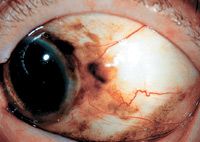Article
Conjunctival PAM uncommon but important disease
Author(s):
Las Vegas-Primary acquired melanosis (PAM) of the conjunctiva is an uncommon but important disease. Although some studies have suggested that it occurs in as much as one-third of the population, most cases do not need treatment. The disease is potentially malignant, however, and arguments can be made for early treatment if risk factors are present, said Jerry A. Shields, MD, in his delivery of the Lorenz E. Zimmerman Lecture here at a combined meeting of the American Academy of Ophthalmology and the American Association of Ocular Pathologists.

The extent of the clock hours involved seems to be very important in predicting the natural course of this disease, noted Dr. Shields, director, oncology service, Wills Eye Institute, and professor of ophthalmology, Thomas Jefferson University, Philadelphia. The guidelines he developed suggest if 1 clock-hour segment is involved, then it is probably safe to observe all lesions. If 2 clock hours are involved, then observation still may be safe.

For those cases that come to surgical excision or biopsy, presence of atypia also is extremely important. If atypia is not present, the risk of progression is close to 0%; if atypia is very mild, then the risk is only about 2%. If severe atypia exists, however, the risk jumps to 32%, Dr. Shields said.
In the mid-1980s, a group of physicians reviewed the Armed Forces Institute of Pathology (AFIP) experience with PAM and declared that, overall, 32% of the cases submitted to the AFIP progressed to melanoma. If the lesions had no atypia histopathologically, however, then the progression rate was 0%. If atypia was present, then progression was 46%, and the pathologists suggested that all lesions be biopsied.1 A subsequent clinical study estimated that PAM was found in 36% of the population but pointed out that many lesions were very small and did not require biopsy. This study used less stringent criteria than the earlier series.2
Neither study addressed the natural course of the disease following diagnosis, so Dr. Shields and his colleagues designed one to address that issue and other questions. The study involved 311 eyes in 276 patients coded as PAM at Wills Eye. The spectrum ranged from very small lesions occupying less than 1 clock-hour segment to more extensive lesions that extended over wide parts of the conjunctiva.
Initial management consisted of observation in 64% of cases, resection, and cryotherapy in 34%, and in 1%, treatment without biopsy using chemotherapy or other approaches. At the 3-year follow-up, 16% of lesions showed enlargement and 8% had progressed to melanoma.
"However, of those that had unequivocal progressive enlargement, 29% developed into melanoma," Dr. Shields said.
Among the lesions that had a biopsy taken so that atypia could be studied, investigators found that the absence of atypia correlated with lack of progression in all cases. They also classified atypia, when present, as mild or severe and found that only one case of mild atypia had progressed to melanoma, compared with 32% of the severe cases.
"When a pathologist saw PAM without atypia, just increased pigmentation of relatively normal melanocytes in the basal layer of the epithelium, 0% progressed to melanoma," Dr. Shields said. "In patients with mildly atypical melanocytes in the epithelium, about 2% progressed. If there was full-thickness epithelial involvement by the atypical melanocytes, then, ultimately, 32% developed melanoma."
Newsletter
Don’t miss out—get Ophthalmology Times updates on the latest clinical advancements and expert interviews, straight to your inbox.




